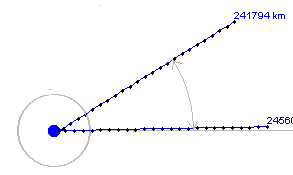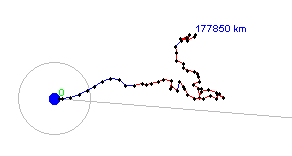
Non-radial Free Siphon
The smooth siphon model removed almost all radial oscillations in 3 ways:
- The siphon is not permitted to accelerate freely from a standing start, but is instead constrained to slow linear acceleration. The result of this is that no hard application of brakes happens, and very little oscillation results.
- New payloads aren't pulled up by the rising siphon, but are instead fired up to its radial velocity before hooking onto it. This removes another source of large radial oscillations. Of course, it means that work has to be done to accelerate payloads up to speed - but since the siphon brakes can generate power, a siphon can in principle power the acceleration of payloads upwards, and so no external work may need to be done.
- The radial oscillations that result from releasing payloads from the top of the siphon are far smaller than these first two, but are still significant. The fix is to release payloads little by little, in small masses. This alone suggests that siphons should consist of chains of closely-spaced small masses rather than widely-spaced large masses.
Until the recent smooth siphon model, all siphons to date have been constrained to a radial path, and largely radially unconstrained in their motion. But given the new smooth siphon model, in which ties and payloads are fed out at a more-or-less steady speed, it became possible to study the behaviour of radially-constrained, laterally-unconstrained siphons.
 The first simulation (click on image to run Java applet) used a 250,000 km chain of some 25 100kg payloads which was allowed to accelerate from standstill slowly - at 0.01 m/s2 - up to a maximum radial speed of 50 m/s. This slow-moving and lightweight siphon gradually accelerated and swung backwards from its direction of rotation while remaining approximately straight along its length. It then continued swinging back and forth, from about 30 degrees back from radial, to about 5 degrees from radial, while releasing payloads from the top.
The first simulation (click on image to run Java applet) used a 250,000 km chain of some 25 100kg payloads which was allowed to accelerate from standstill slowly - at 0.01 m/s2 - up to a maximum radial speed of 50 m/s. This slow-moving and lightweight siphon gradually accelerated and swung backwards from its direction of rotation while remaining approximately straight along its length. It then continued swinging back and forth, from about 30 degrees back from radial, to about 5 degrees from radial, while releasing payloads from the top.
 In a second simulation, the same siphon was restricted to an acceleration of 0.0001 m/s2. This siphon took several days to reach 50 m/s, and simply slowly deflected backwards from radial, and maintained a more or less stable angle to radial, swinging slightly.
In a second simulation, the same siphon was restricted to an acceleration of 0.0001 m/s2. This siphon took several days to reach 50 m/s, and simply slowly deflected backwards from radial, and maintained a more or less stable angle to radial, swinging slightly.
It is clear that such siphons behave very like the space elevators to which they are closely related, which also either swing to and fro back from radial, or maintain a constant angle to radial.
In a third simulation (not shown), the maximum speed was increased to 100 m/s, and the siphon swung back some 60 degrees, and showed signs of deformation. This suggests that while such siphons function, they raise relatively low masses at low velocities.
 By contrast, a freely accelerating siphon rapidly becomes deformed and misshapen, as was originally demonstrated in the first siphon simulations. This was the reason why all subsequent siphons were constrained to a radial path.
By contrast, a freely accelerating siphon rapidly becomes deformed and misshapen, as was originally demonstrated in the first siphon simulations. This was the reason why all subsequent siphons were constrained to a radial path.
 The next siphon model feeds out tether and payloads at whatever speed is demanded. And in the case of the freely accelerating siphon, the collapsing siphon occasionally, indeed perhaps regularly, jerks up a fast stream of masses, which is sustained because the new masses are automatically fed up into the stream. Indeed, one of these can be seen in formation at the base of the collapsing siphon. These fast 'siphons' are really just mass chains being fired out radially from the terrestrial equator, with speeds of several thousand m/s, curving back from radial. They are interesting, but they require launch speeds in excess of escape velocity (11 km/s).
The next siphon model feeds out tether and payloads at whatever speed is demanded. And in the case of the freely accelerating siphon, the collapsing siphon occasionally, indeed perhaps regularly, jerks up a fast stream of masses, which is sustained because the new masses are automatically fed up into the stream. Indeed, one of these can be seen in formation at the base of the collapsing siphon. These fast 'siphons' are really just mass chains being fired out radially from the terrestrial equator, with speeds of several thousand m/s, curving back from radial. They are interesting, but they require launch speeds in excess of escape velocity (11 km/s).
Conclusions
It would appear from these simulation models that it is not actually necessary to make a siphon rigid for it to work. It appears that all that is needed to create a working siphon is a long piece of string.
However, a completely non-rigid siphon - a piece of string - is only able to raise mass at a slow rate. The higher the mass flow rate, the more the non-rigid siphon deflects from radial. And the more rigid a siphon becomes, the greater the mass flow rate. So there exists a range of possible siphons, with one extreme being an entirely non-rigid siphon, and the other a perfectly rigid siphon.
The reason I missed the possibility of a non-rigid siphon was that my 1996 simulation models simply fed out mass too rapidly, applied too hard braking, and loaded and released mass too suddenly. If I had constrained my early models to accelerate very slowly, I would have discovered that there was actually no need for the radial rigidity that I imposed upon them to make them work.
